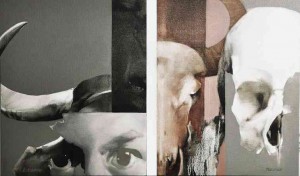
Whether the Roman god Janus or DC Comics’ vile Two-Face from the “Batman” series, two-sidedness or bipolarity is viewed as dark and portentous. It connotes extreme duality and oftentimes suggests indecision, even falsity.
But Arte Pintura Gallery dispels all these notions with “Doble Kara,” a group show that tackles perceptions of the negative and the positive in artists’ obra through the presence and absence of color. With each of the 24 participating artists tasked to come up with twin works of a similar theme (one in monochrome and the other colored), presented in the exhibit is a total of 48 artworks—all without the negative connotation of dichotomy.
“‘Doble Kara’ was conceptualized to flaunt artists’ versatility, to showcase expressions of monochrome and color. We chose to go with a more figurative take on the expression doble kara, which literally translates to ‘two faces.’ So in a way, what we offer to viewers is two faces of the same artist,” said Arte Pintura Gallery managing curator Azor Pazcoguin, whose work can also be seen in the collection.
Visual double-spread
Pazcoguin’s “Bully the Kid” 1 and 2 are both stamped with the realist’s flair in their anatomical rendering. They are even paired with a literary piece by Rommel Eugrafia that bears the same title as the paintings. A pair of brute eyes holds a piercing stare in the first “Bully the Kid.” Set only in a play of light and dark, it is obvious that one of the two heads that are incorporated in the work is human, and the other is that of a bull. “Bully the Kid 2” has the same grays and whites and blacks, but the work is made striking by a portion in tones of clay, sand and rust. This time, the bull’s head is nothing but bone, and alongside it, a human skull.
In his poem, Eugrafia insinuates the inevitable reality of mortality and death’s role as the ultimate equalizer.

A fresh break from Pazcoguin and Eugrafia’s editorial collaboration are Flor Baradi’s and artist-gallery owner Addie Cukingnan’s floral diptychs. While Cukingnan spotlights a single peony at the peak of its bloom in “Sa Pula sa Puti,” Baradi delights with “Feral Bouquet,” an elaborate selection of carnivorous plants. Both Cukingnan and Baradi have black-and-white renditions of their flora, but the former chose to alternately capture the blossoming of the peony in a vivacious red, which, according to Cukingnan, symbolizes joy in Chinese culture. Baradi stays faithful to the still-life palette of her meat-eating plants.
Lei Manto turns to popular icons for his twin paintings, which both seem to be unfinished puzzles that reveal the identities of his subjects. His “What if Charlie is Sad” shows slapstick idol Charlie Chaplin donning a mask and an uncharacteristic smile, while “Beauty Behind the Mask” coyly features Marilyn Monroe in all her sultry glory.
Ronald Jeresano and Marge Lim put forth their varied phases through images of the mundane and the reverent. Jeresano’s “Palace (The Making)” depicts mirror images of the same construction site. While one scene seems to be a gradient of gray, the other is made a tad more alive with the muted colors of wood and stone. Jeresano adorns his unfinished structures with a crown each, assigning a gold-and-crimson headpiece to the work in grayscale, while a silver-and-black crown graces the other.
Lim delicately portrays candle offerings of the faithful, often seen in places of worship. Both can be mistaken for photographs from afar, only the focus is made softer by Lim’s brushstrokes.
Among the abstractionists are Max Balatbat and writer-critic-artist Cid Reyes. Balatbat’s mixed-media “Hawla sa Umaga” and “Hawla sa Gabi” are both a hodgepodge of paint, string and fabric. Reyes, on the other hand, treats audiences to his signature prismatic abstract in “Rainbow Forest.” Its counterpart, “Forest,” is made crisp in ivory and ebony.
“Doble Kara” is on view at the Arte Pintura Gallery, ground floor, The Address, Wack Wack Road, Mandaluyong City. Call 6310898 or e-mail artepinturagallery@yahoo.com for more details.













































